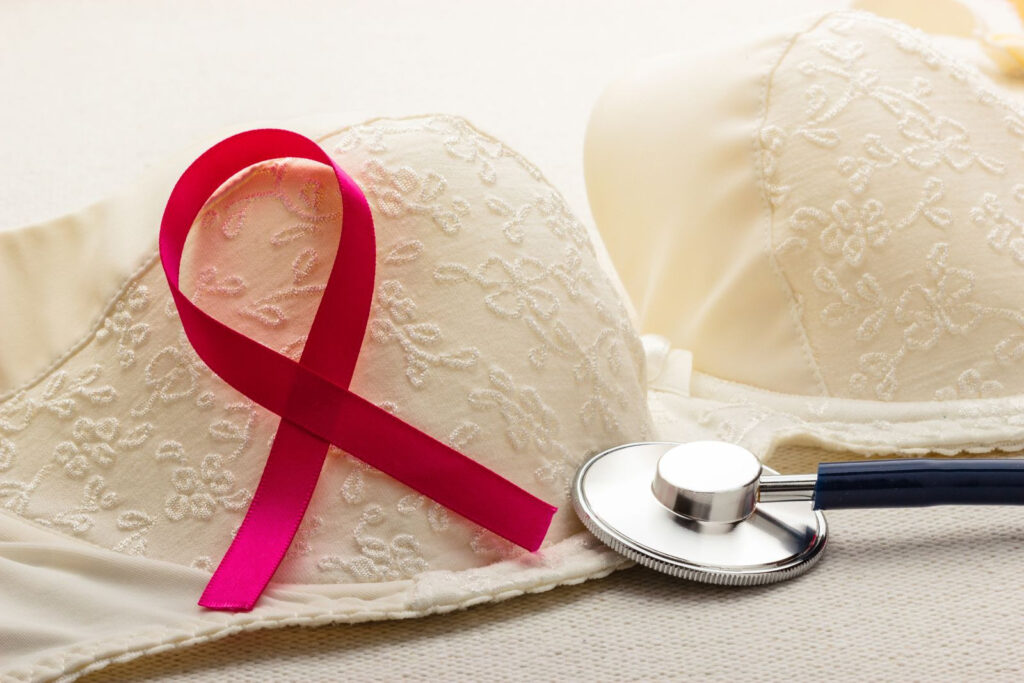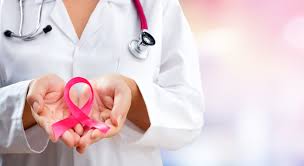If you’re an average woman, your risk of breast cancer is one in eight. But why be “average”? You can significantly reduce your risk of breast, uterine, and other estrogen-related cancers right now with foods and selected supplements.
But first you have to determine just how at risk you are.
There are two methods I recommend for evaluating estrogen-related cancer risk. They both involve ratios of various estrogen metabolites. I’m talking about the 2/16 ratio test and the estrogen quotient, or EQ. Last month, we spent some time going over all the intricacies of just how these ratios work to add up your risk of breast and other estrogen-related cancers. This month, let’s move on and talk about what’s involved in taking these tests and what to do if your results aren’t as good as you’d like. And before all you men tune out, estrogen risk factor testing is important for you too! We’ll get to that a little later in the issue.
The good news is, testing your own risk couldn’t be easier. You don’t even have to leave home to do it.
What’s your EQ?
In the June issue, I told you about the importance of an estogen metabolite called estriol. The recent resurgence in estriol research is confirming the discoveries made in the mid-20th century: Estriol is a “good” estrogen. More estriol means less cancer risk. Estriol appears to block many of the effects of estradiol (E2), estrone (E1), and other “pro-carcinogenic” estrogens. So how do you find out if your body is producing enough estriol to protect you from cancer? You calculate your EQ.
Dr. Henry Lemon, the originator of the EQ test, tested estriol along with estrone and estradiol by having women collect their urine for 24-hours, then measuring the hormone levels in the specimens. It’s still done the same way, although some changes in the actual testing equipment have made the process a lot easier. In fact, the testing kits can be mailed to you at home, where you can collect your specimen and send it back to the lab.
Even though you’ll need to collect all your urine for a 24-hour period, only a small amount is actually mailed in for testing.
If you haven’t gone through menopause yet, and you have a menstrual cycle that follows the typical 28-day pattern, pick a 24-hour period between days 19 and 23 of your cycle (day 1 being the first day of menstrual bleeding) to collect your sample. If you’ve already gone through menopause, you can collect your sample anytime.
Once you send your sample back to the lab, it generally takes about two to three weeks to get your results.

The virtually fail-safe EQ-booster: You may only need one drop a day
When your results arrive in the mail, you’ll see all of your different hormone levels listed. The ones we’re most concerned with for determining breast cancer risk via the EQ are estriol, estrone, and estradiol. Remember, it’s not the absolute amount of estriol that appears to be the most important number but the relative amount of estriol compared with the sum of estradiol and estrone. In mathematical terms, it looks like this: EQ= E3 / (E2 + E1).
The lab report might already have your EQ calculated and listed. Some labs today consider EQs of 0.4 to 0.6 as normal. But when Dr. Lemon did his research back in the 1960s and 1970s, he found that women need an EQ of at least 1.0 (this level or above was considered favorable; the further below 1.0, the more unfavorable). So was Dr. Lemon wrong?
Well, let’s put it this way: If women only need an EQ of 0.4, why has breast cancer risk gone up? Not only do I think you still need an EQ of at least 1.0, as Dr. Lemon found 40 years ago, but in today’s environment, with the amount of estrogen-mimicking carcinogens increasing dramatically, it’s more important than ever to keep your level of estriol as high as possible. So I don’t see any reason why we shouldn’t still follow Dr. Lemon and shoot for an EQ of 1.0 or above.
If your EQ is below 1.0, there’s a simple, almost fail-safe solution: SSKI. You might remember this remedy from the November 2002 issue of Nutrition & Healing. It has certainly proven itself as a natural cure-all, and its effects on the EQ just reinforce that reputation. In case you missed the full article on it, SSKI is a solution that combines iodine and potassium. It’s the iodine that works to boost the EQ: Iodide (and iodine) reliably promote the metabolism of estrone and estradiol into estriol. Although (so far) there haven’t been any official studies on this, I’ve observed these effects in hundreds of my patients’ lab tests.
Take six to eight drops of SSKI mixed in several ounces of water daily for two to three months. Then repeat your test, doing the 24-hour urine collection at the same time of the month as your first one. More likely than not, your follow-up EQ will be above 1.0-sometimes considerably above. If it is, try tapering down the SSKI to the smallest amount that helps you maintain your EQ at 1.0 or above. Some women find that they only need one drop a day, though others need more.
Although SSKI is safe for the overwhelming majority of people, there are individuals who are very sensitive to it. On rare occasion, long-term use of larger quantities of SSKI may cause thyroid suppression. Thyroid blood tests, which you can also do on your own (or with your doctor’s help), always pick up on this if it occurs. For more information on using SSKI safely, see the November 2002 issue (you can download it free on the Nutrition & Healing website, www.wrightnewsletter.com).
The “random” urine test that could save your life

If you’ve been reading Nutrition & Healing for a few years, you probably remember seeing at least a few references to the 2/16 ratio test. According to nearly 20 years of research, 2-hydroxyestrogens are “good” while 16-hydroxyestrogens are “bad” and promote cancer growth.
Testing the 2/16 ratio can be done separately or along with the EQ. If you opt to have it done separately, you don’t need to collect 24 hours’ worth of urine-you’ll only need to send in one random specimen. But, like the EQ test, if you’re pre-menopausal, try to collect the urine specimen during days 19 to 23 of your 28-day cycle, and be sure to note the cycle day and time, in case you need to take a repeat test or two. When you’ve collected your sample, just mail it back to the lab.
Eat your way to a breast cancer-free future
You definitely want more “good” (2) estrogen than “bad” (16) estrogen-substantially more if possible. So when you get your results, check the proportion of these two substances: Any ratio below 1.0 is unfavorable. Although there’s no consensus on an ideal ratio number, I recommend 2.0 or greater if possible.
If your 2/16 ratio is less than 1.0, there’s a good chance you’ll be able to boost it just by eating a few specific foods. Start with Brassica (or mustard family) vegetables. These include cabbage, broccoli, cauliflower, bok choy, Brussels sprouts and many others. You can also eat freshly ground flaxseed, 1 tablespoonful daily. And even though there’s been a great deal of controversy surrounding it, in this case, incorporating soy products (tofu, tempeh, soy milk, etc.) into your diet is a good option for boosting 2/16 ratios. A little goes a long way though, and two or three servings a week is plenty. You also don’t need to go overboard with Brassica vegetables. I know it seems odd for me to be warning you not to eat too many vegetables, but it is possible for Brassicas to cause suppressed thyroid function and even goiter if you eat a lot of them on a daily basis. Three to four servings a week is a good general range.
You might find that you only need to incorporate one of these foods into your diet to raise your 2/16 ratio, but sometimes it takes two or even all three to make a big difference. In a lot of cases, just eating these foods will bring a low 2/16 ratio to 1.0 or above in just four to six weeks without any other specific supplementation. But if you find you’re still not getting sufficient improvement, you can also take di-indolylmethane (DIM) supplements to boost it even further. DIM is actually a substance found in Brassica vegetables, but it’s also available in most health food stores in supplement form. If you need some extra help, take 60 milligrams three times daily, and check your 2/16 ratio again in another four to six weeks.
Start today to make sure you’re cancer-free tomorrow
So, you see, there’s no reason to just wait and hope that you’re not that one woman in eight who gets breast cancer. The 2/16 ratio and the EQ provide two easy ways to estimate your own risk of breast, uterine, and other estrogen-related cancers.
For more information on these tests, contact a physician-member of ACAM or ICIM, or Meridian Valley Laboratory (see the “Resources” section on page 8 for details). Meridian Valley is actually located in Washington state where, by law, individuals can order their own lab tests. I am affiliated with Meridian Valley Lab; in fact, I’m the one who insisted they start testing the EQ and the 2/16 ratio so I could make these valuable cancer risk factor tests available to all of my patients.
If your risk factor calculations are unfavorable, or even if they’re just OK, there are things you can do yourself-starting today-to lessen your breast cancer risk. Cancer is a frightening thing, but don’t let that fear paralyze you: Do something about it-and pass the information along to your daughters and granddaughters, too!
More to read: Strontium – Fight-even prevent-osteoporosis with the hidden secrets of this bone-building miracle mineral
